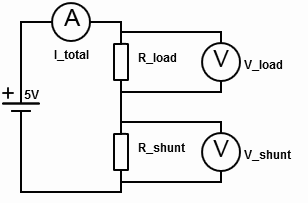Shunt: Unterschied zwischen den Versionen
Tut (Diskussion | Beiträge) |
|||
| (6 dazwischenliegende Versionen von einem anderen Benutzer werden nicht angezeigt) | |||
| Zeile 9: | Zeile 9: | ||
'''In Detail:'''<br> | '''In Detail:'''<br> | ||
The best way to get a better understanding is to have a look at the principle of voltage divider.<br> | The best way to get a better understanding is to have a look at the principle of voltage divider.<br> | ||
| − | [[Datei: | + | [[Datei:Voltage-divider-shunt.png]]<br> |
In a voltage divider the current is always the same.<br> | In a voltage divider the current is always the same.<br> | ||
[[Datei:I_total.gif]]<br> | [[Datei:I_total.gif]]<br> | ||
| Zeile 18: | Zeile 18: | ||
[[Datei:r_total_shunt.gif]]<br> | [[Datei:r_total_shunt.gif]]<br> | ||
[[Datei:ratio_r_shunt.gif]]<br> | [[Datei:ratio_r_shunt.gif]]<br> | ||
| − | [[Datei: | + | [[Datei:v_drop_shunt.gif]]<br> |
-> This tells us that we have to choose the resistor as small as possible so that we don’t drag to much voltage from the load. | -> This tells us that we have to choose the resistor as small as possible so that we don’t drag to much voltage from the load. | ||
| − | This table displays how the resistance value of the | + | This table displays how the resistance value of the R_shunt drains power if it is too high. |
Also you can see how small the voltage drop gets if the resistance is to low, what makes it hard to measure. | Also you can see how small the voltage drop gets if the resistance is to low, what makes it hard to measure. | ||
| Zeile 29: | Zeile 29: | ||
! I (total) | ! I (total) | ||
! U (total) | ! U (total) | ||
| − | ! | + | ! R_load |
| − | ! | + | ! R_shunt |
| − | + | ! U (load) | |
| − | + | ! U (shunt) | |
| − | ! P(lost) | + | ! P (lost) |
|- | |- | ||
| 0,25A | | 0,25A | ||
| Zeile 56: | Zeile 56: | ||
| 0.1 | | 0.1 | ||
| 4.975V | | 4.975V | ||
| − | | 0. | + | | 0.025V |
| 0.00625W | | 0.00625W | ||
|} | |} | ||
Aktuelle Version vom 4. September 2015, 12:28 Uhr
Inhaltsverzeichnis
How does a shunt works?
Short:
A shunt is a very small resistor that is used to measure current.
The resistor is added in series to the load and the voltage drop is measured.
From the voltage drop and the value of the resistor the current can be calculated.
In Detail:
The best way to get a better understanding is to have a look at the principle of voltage divider.

In a voltage divider the current is always the same.
![]()
-> Means we can really use a second resistor to find out the current that is flowing through the load.
Every resistor has a voltage drop that has the ratio of the resistor to the total resistance.
![]()
![]()
![]()
-> This tells us that we have to choose the resistor as small as possible so that we don’t drag to much voltage from the load.
This table displays how the resistance value of the R_shunt drains power if it is too high.
Also you can see how small the voltage drop gets if the resistance is to low, what makes it hard to measure.
| I (total) | U (total) | R_load | R_shunt | U (load) | U (shunt) | P (lost) |
|---|---|---|---|---|---|---|
| 0,25A | 5V | 10 | 10 | 2.5V | 2.5V | 0.625W |
| 0,25A | 5V | 19 | 1 | 4.75V | 0.25V | 0.0625W |
| 0,25A | 5V | 19.9 | 0.1 | 4.975V | 0.025V | 0.00625W |
How to measure
Arduino
Usages
- Energy generation
- Energy consumption
- Battery charging
Alternatives
Hall-Effect current sensing